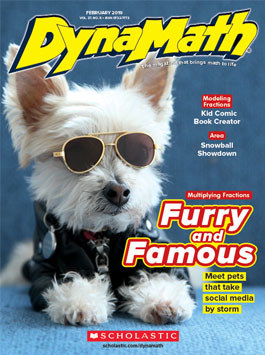All too often, math is a particularly vulnerable subject to summer slide. But we’ve got you covered. Here are five fun, real-world ways to fight summer slide and keep student’s math skills sharp. They’re perfect for sharing with parents.

School’s out, but math is still in!
Real-world math is everywhere. Here are 5 ways you can fight the summer slide.
1. Summer reading with a math twist
There are wonderful children’s titles that incorporate mathematic principles in fun and engaging ways. Actual Size by Steven Jenkins includes concepts of scale and proportion, the Sir Cumference series explores geometry and ratios in a fantasy world, while How Much is a Million by David Schwartz is all about numeracy. For more advanced readers, Holes by Louis Sachar and The Lemonade War by Jacqueline Davies are engrossing summer reads that inspire thinking about math.
2. Find math in sports
From a pickup soccer match to the Olympic games, every sport has tons of numbers kids can work with! For example, kids swimming laps at the pool can use multiplication to determine the total distance they swam. Or encourage them to use division to calculate the batting averages of their favorite baseball team.
3. Cook up some math
Lighting up the grill? Prepping a potato salad? Cooking is a great time to talk to kids about the multiplication, division, and measurement conversions required to make a meal. Especially if you have to double or halve a recipe. Plus they’ll create delicious manipulatives!
4. Create math-inspired art
Summer art projects provide excellent opportunities for unstructured learning. Symmetrical painting projects help students explore reflecting images over an axis. Students can also incorporate patterns and use tessellations in their paintings and drawings.
5. Gardening with math in mind
Whether you’re in the ‘burbs or a city dweller, working on your green thumb requires an understanding of math. Students can practice their measurement skills when they plant seeds, water them, or record plant growth.
With the right encouragement, kids can apply their math knowledge during their everyday summer activities, keeping their skills sharp. Their new teachers will appreciate it in the fall.
Want more elementary math education tips and news? Check out Scholastic's archive.
John R. Hering is a graduate student at The Fletcher School of Law and Diplomacy at Tufts University. He is a former school administrator, teacher, and Teach For America corps member in Houston, Texas.
Recent Posts
-
July 7, 2021
SEL in the Math Classroom: Strategies for Resilience
-
January 30, 2019
Make the Most of DynaMath–With Google Classroom!
-
January 8, 2019
Easy Classroom Updates for 2020
-
December 3, 2019
4 Fun Ways to Use Math Around the Holidays
-
September 10, 2019
Fun Math Icebreaker Activity
Exciting ideas and fun teaching strategies for using DynaMath in 3rd, 4th, and 5th grade math classrooms


